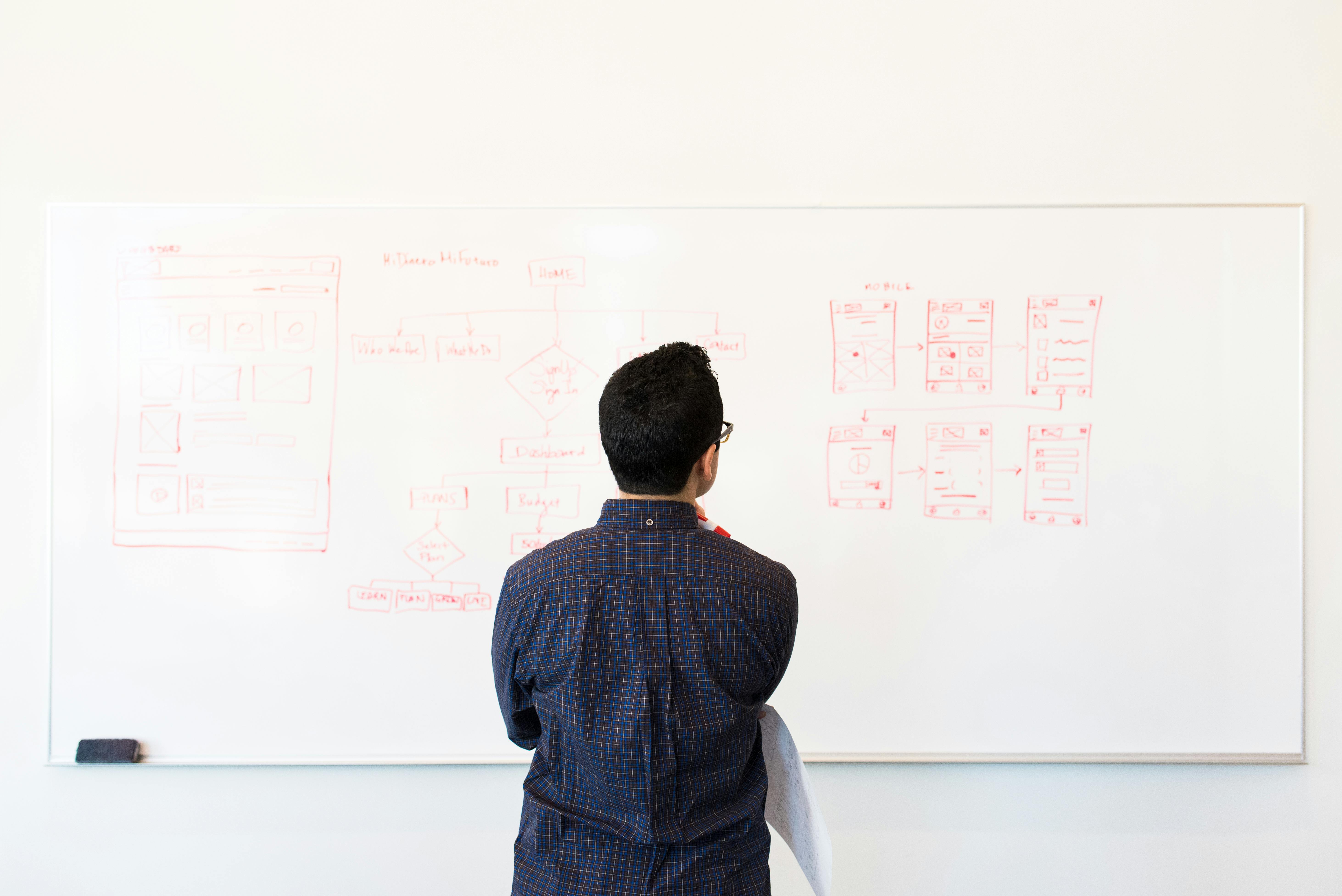Lead Generation
B2B Lifecycle Strategy: Key Stages, Challenges, and Tips
Discover B2B lifecycle strategy with insights on overcoming challenges, best practices, and measuring success.
Sep 11, 2024

Successful businesses excel in retaining clients through effective B2B lifecycle strategy. This approach is crucial for nurturing business relationships, from initial contact to long-term partnerships
Think of it as a roadmap for building lasting connections in the business world. You'll learn how to attract potential clients, win them over, and keep them happy for years to come. It's like having a secret playbook for success in the competitive B2B world.
Understanding B2B Lifecycle Strategy
A B2B lifecycle strategy is your roadmap for nurturing business relationships from initial contact to long-term partnership. It's like tending a garden, where you plant seeds (reach potential clients), water them (acquire and convert), and continue caring for the plants (retain and grow) to ensure a bountiful harvest.
Key stages in a B2B lifecycle strategy include:
Reach and Awareness: This is your first impression. You're casting a wide net through content marketing, social media, and targeted ads. It's like hosting a party – you want to create buzz and get people talking about your brand.
Acquisition: Here, you're educating prospects about your offerings. Think of it as a first date – you're showcasing your best qualities and demonstrating value.
Conversion: This is where the magic happens. You've wooed your prospect, and now they're ready to commit. It's like sealing the deal on a house purchase – negotiations, paperwork, and finally, a signature.
Retention: Now you're in it for the long haul. Like any good relationship, it requires ongoing nurturing. Regular check-ins, personalized support, and adding value keep the spark alive.
Growth: This is where you take things to the next level. You're not just maintaining the relationship; you're expanding it. It's like turning a casual friendship into a deep, meaningful bond.
Common misconceptions about B2B lifecycle strategies:
It's a linear process: In reality, it's more of a cycle. Clients can move back and forth between stages.
It's all about acquiring new clients: While important, retaining existing clients is often more cost-effective.
One size fits all: Every business is unique, and your strategy should reflect that.
To avoid these pitfalls:
Map out your customer journey and identify touchpoints at each stage.
Invest in robust customer relationship management (CRM) tools to track interactions and preferences.
Tailor your approach to each client's specific needs and industry.
Different techniques for different stages:
Reach: Use SEO-optimized content, targeted LinkedIn ads, and industry events.
Acquisition: Offer free trials, demos, or consultations to showcase your value.
Conversion: Employ personalized proposals and ROI calculators.
Retention: Carry out loyalty programs and regular performance reviews.
Growth: Upsell complementary products or services based on usage data.
Incorporating best practices:
Align your sales and marketing teams with a cohesive approach.
Use data analytics to track customer behavior and preferences.
Create personalized content for each stage of the lifecycle.
Regularly seek feedback and adjust your strategy accordingly.
Invest in ongoing training for your team to stay updated on industry trends.
Remember, a successful B2B lifecycle strategy is about building relationships, not just closing deals. It's a marathon, not a sprint, so pace yourself and focus on creating long-term value for your clients.
Key Components of B2B Lifecycle Strategy

A successful B2B lifecycle strategy hinges on three fundamental components. These components work together to create a comprehensive approach that maximizes customer value throughout their journey with your business.
Customer Acquisition
Customer acquisition is the first step in your B2B lifecycle strategy. It's all about attracting potential customers and turning them into paying clients. Here's how to optimize your acquisition efforts:
Use targeted advertising to reach your ideal customers on platforms they frequent, using tools like GrowLeady to fine-tune your ad targeting and optimize engagement.
Create SEO-optimized content that addresses your prospects' pain points
Leverage social media to build brand awareness and engage with potential clients
Carry out lead nurturing campaigns to guide prospects through your sales funnel
Offer valuable resources like whitepapers or webinars to capture leads
Remember, acquisition isn't just about getting any customer—it's about attracting the right customers who'll benefit most from your products or services.
Customer Retention
Once you've acquired customers, the next crucial step is keeping them. Customer retention focuses on maintaining relationships and ensuring clients continue to find value in your offerings. Here's how to boost retention:
Provide exceptional customer service with quick response times and personalized support
Regularly communicate with clients through newsletters, product updates, and check-ins
Offer loyalty programs or exclusive benefits for long-term customers
Continuously gather and act on customer feedback to improve your products and services
Provide ongoing training and resources to help customers maximize the value of your offerings
Remember, it's often more cost-effective to retain existing customers than to acquire new ones. Invest in building strong, lasting relationships with your clients.
Customer Growth
The final component of a B2B lifecycle strategy is customer growth, also known as expansion. This phase focuses on increasing the value of existing customer relationships. Here's how to drive growth:
Identify upsell and cross-sell opportunities based on customer usage patterns
Develop new products or services that complement your existing offerings
Carry out account-based marketing strategies to target high-value clients
Encourage and incentivize customer referrals
Host exclusive events or webinars for existing customers to showcase new features or products
By focusing on customer growth, you're not just maintaining relationships—you're actively expanding them, increasing customer lifetime value, and fostering brand advocates.
Remember, these components aren't isolated stages but interconnected parts of a continuous cycle. By mastering each component and understanding how they work together, you'll create a robust B2B lifecycle strategy that drives long-term success for your business.
Stages of the B2B Customer Lifecycle
The B2B customer lifecycle consists of distinct stages that guide prospects from initial awareness to long-term partnership. Understanding these stages helps businesses tailor their approach and maximize customer engagement throughout the journey.
Awareness and Discovery
In the awareness and discovery stage, your goal is to capture the attention of potential customers. Use targeted advertising, content marketing, and SEO to increase brand visibility. Create thought leadership content, such as blog posts, whitepapers, and industry reports, to establish your expertise. Leverage social media platforms like LinkedIn to share valuable insights and engage with your target audience.
Consideration and Evaluation
During this stage, provide detailed information to help prospects evaluate your offerings. Develop comprehensive product guides, case studies, and comparison charts to showcase your solutions' benefits. Offer free trials or demos to give potential customers hands-on experience with your product. Host webinars or virtual events to address common pain points and demonstrate how your offerings solve specific challenges.
Purchase Decision
To convert leads into customers, focus on building trust and demonstrating value. Provide personalized proposals that address each prospect's unique needs. Offer flexible pricing options and highlight the ROI of your solution. Use customer testimonials and success stories to reinforce the benefits of choosing your product or service. Carry out a streamlined sales process to make the purchasing decision as smooth as possible.
Onboarding and Implementation
After the purchase, ensure a smooth onboarding process to set the foundation for a successful partnership. Develop a comprehensive onboarding plan that includes training sessions, documentation, and dedicated support. Assign a customer success manager to guide new clients through the implementation process. Set clear milestones and regularly check in to address any concerns or challenges.
Ongoing Support and Expansion
In this stage, focus on nurturing long-term relationships and identifying growth opportunities. Provide proactive support through multiple channels, including phone, email, and chat. Carry out a customer feedback loop to continuously improve your products and services. Offer additional training and resources to help clients maximize the value of your solution. Identify upsell and cross-sell opportunities based on customer usage patterns and needs.
Benefits of Implementing a B2B Lifecycle Strategy
Adopting a B2B lifecycle strategy offers numerous advantages for your business. Here's why it's a game-changer:
Increased Customer Retention
A well-executed lifecycle strategy keeps customers engaged long after the initial sale. You'll see a significant boost in customer loyalty, reducing churn rates and increasing lifetime value. For example, a software company implementing personalized onboarding and regular check-ins saw a 30% increase in customer retention within six months.Higher Revenue Growth
By focusing on the entire customer journey, you'll uncover more upselling and cross-selling opportunities. Existing customers are 50% more likely to try new products and spend 31% more compared to new customers. This approach leads to steady revenue growth without the high costs associated with acquiring new clients.Improved Customer Satisfaction
A lifecycle strategy ensures you're meeting customer needs at every stage. This proactive approach leads to higher satisfaction rates and positive word-of-mouth referrals. Companies with strong lifecycle strategies report Net Promoter Scores (NPS) up to 20 points higher than their competitors.Enhanced Efficiency
By mapping out the customer journey, you'll identify areas for automation and optimization. This streamlines your processes, reducing costs and freeing up resources. For instance, implementing automated email sequences for onboarding can save your team 10+ hours per week while improving the customer experience.Data-Driven Decision Making
A lifecycle strategy provides valuable insights into customer behavior at each stage. You'll make more informed decisions about product development, marketing strategies, and resource allocation. Companies leveraging customer lifecycle data report a 25% increase in marketing ROI.Competitive Advantage
In today's crowded B2B marketplace, a well-executed lifecycle strategy sets you apart. You'll build stronger relationships with clients, becoming a trusted partner rather than just another vendor. This differentiation can lead to a 10-15% increase in win rates against competitors.Reduced Customer Acquisition Costs
Happy customers become brand advocates, reducing your reliance on expensive outbound marketing tactics. Referrals from satisfied clients can lower customer acquisition costs by up to 50% compared to traditional marketing methods.Aligned Sales and Marketing Efforts
A lifecycle strategy encourages collaboration between sales and marketing teams. This alignment results in more effective lead nurturing and higher conversion rates. Companies with strong sales and marketing alignment achieve 20% annual revenue growth on average.
By implementing a B2B lifecycle strategy, you're not just optimizing individual touchpoints – you're creating a cohesive, customer-centric approach that drives sustainable growth and long-term success.
Challenges in B2B Lifecycle Management
Managing the B2B lifecycle isn't always smooth sailing. You'll encounter several hurdles along the way, but don't worry - being aware of these challenges is the first step to overcoming them.
Data Silos and Integration Issues
Imagine trying to solve a puzzle with pieces scattered across different rooms. That's what dealing with data silos feels like. Many B2B companies struggle to integrate data from various departments and systems. This fragmentation makes it tough to get a complete picture of your customers' journey.
To tackle this:
Carry out a centralized customer data platform
Encourage cross-departmental collaboration
Invest in integration tools that connect your existing systems
Personalization at Scale
You know personalization is crucial, but how do you tailor experiences for hundreds or thousands of unique businesses? It's like being a chef trying to customize meals for an entire restaurant of picky eaters.
Here's how to approach it:
Use AI and machine learning to analyze customer data and predict preferences
Create buyer personas and segment your audience
Leverage dynamic content in your marketing materials
Long and Complex Sales Cycles
B2B sales cycles are often longer than a cross-country road trip. With multiple decision-makers involved, it's easy to lose momentum or drop the ball.
To keep things moving:
Develop a clear roadmap for each stage of the sales process
Use automation to nurture leads consistently
Provide value at every touchpoint to maintain engagement
Aligning Sales and Marketing Teams
When sales and marketing teams aren't in sync, it's like trying to dance the tango with two left feet. Misalignment can lead to inconsistent messaging and missed opportunities.
Improve alignment by:
Setting shared goals and KPIs
Implementing regular cross-team meetings
Creating a unified customer view accessible to both teams
Measuring ROI Across the Lifecycle

Tracking the return on investment (ROI) across the entire B2B lifecycle can feel like trying to measure the ocean with a teaspoon. Different stages require different metrics, and attributing success can be tricky.
To improve ROI measurement:
Define clear metrics for each lifecycle stage
Use attribution modeling to understand touchpoint impact
Invest in analytics tools that provide a holistic view of customer interactions
Adapting to Changing Customer Expectations
B2B buyers are becoming more like B2C consumers, expecting seamless, personalized experiences. It's like suddenly having to cater to a five-star restaurant clientele when you've been running a casual diner.
Stay ahead of changing expectations by:
Regularly surveying your customers and prospects
Monitoring industry trends and competitor offerings
Investing in user experience (UX) design for all customer touchpoints
Managing Customer Churn
Losing customers is like watching sand slip through your fingers. In B2B, where each client represents significant value, churn can be particularly painful.
To reduce churn:
Carry out an early warning system to identify at-risk customers
Develop a proactive customer success program
Regularly gather and act on customer feedback
By recognizing these challenges and implementing strategies to address them, you'll be better equipped to navigate the complexities of B2B lifecycle management. Remember, it's an ongoing process of learning and adapting - stay flexible, and you'll find your rhythm in no time.
Best Practices for Effective B2B Lifecycle Strategy
Implementing a successful B2B lifecycle strategy requires a thoughtful approach and continuous refinement. Here are some best practices to optimize your efforts:
Personalize your approach
Tailor your messaging and content to each stage of the customer journey. Use data-driven insights to create personalized experiences that resonate with your target audience. For example, send customized email campaigns based on a prospect's industry, company size, or previous interactions with your brand.Align sales and marketing teams
Foster collaboration between your sales and marketing departments to ensure a seamless customer experience. Carry out regular meetings, shared goals, and integrated systems to help communication and data sharing. This alignment helps create a unified message and consistent approach throughout the customer lifecycle.Leverage marketing automation
Use marketing automation tools to streamline your processes and deliver timely, relevant content to prospects and customers. Automation can help you nurture leads, trigger personalized follow-ups, and track customer behavior across multiple touchpoints.Focus on value-driven content
Create high-quality, informative content that addresses your customers' pain points and provides real value. This might include how-to guides, industry reports, case studies, or webinars. By positioning your brand as a trusted resource, you'll build credibility and strengthen relationships throughout the lifecycle.Carry out a robust customer onboarding process
Develop a comprehensive onboarding program to ensure new customers get maximum value from your product or service. This might include personalized training sessions, video tutorials, or a dedicated customer success manager. A smooth onboarding experience sets the foundation for long-term customer satisfaction and retention.Prioritize customer retention and loyalty
Don't neglect existing customers in your pursuit of new business. Carry out strategies to keep your current customers engaged and satisfied, such as:
Regular check-ins and account reviews
Exclusive loyalty programs or rewards
Personalized upsell and cross-sell opportunities
Proactive customer support and issue resolution
Measure and optimize performance
Regularly track key performance indicators (KPIs) across each stage of the lifecycle. Use analytics tools to monitor metrics such as:
Customer acquisition cost (CAC)
Customer lifetime value (CLV)
Conversion rates at each stage
Customer satisfaction scores
Churn rate
Use these insights to identify areas for improvement and refine your strategy over time.
Embrace account-based marketing (ABM)
For high-value accounts, consider implementing an ABM approach. This involves creating highly targeted, personalized campaigns for specific accounts or groups of accounts. ABM can lead to higher conversion rates and stronger relationships with key clients.Invest in customer education
Develop ongoing educational resources to help customers maximize the value of your product or service. This might include:
Regular product updates and feature announcements
Industry trend reports and best practices guides
User groups or communities for peer-to-peer learning
Advanced training sessions or certification programs
By continuously educating your customers, you'll increase their engagement and likelihood of long-term success with your solution.
Gather and act on customer feedback
Carry out a systematic approach to collecting and analyzing customer feedback throughout the lifecycle. Use surveys, interviews, and social media monitoring to gain insights into customer satisfaction, pain points, and areas for improvement. Act on this feedback to continuously enhance your products, services, and overall customer experience.
By incorporating these best practices into your B2B lifecycle strategy, you'll be better equipped to attract, convert, and retain high-value customers in today's competitive business world. Remember, success in B2B relationship management requires ongoing adaptation and a commitment to delivering value at every stage of the customer journey.
Measuring Success in B2B Lifecycle Strategy
Measuring success in your B2B lifecycle strategy is like keeping score in a game – it helps you know if you're winning or need to adjust your tactics. Here's how you can effectively gauge your strategy's performance:
Key Performance Indicators (KPIs)
Track these essential KPIs to assess your B2B lifecycle strategy:
Customer Acquisition Cost (CAC): Calculate how much you spend to gain a new customer.
Customer Lifetime Value (CLV): Determine the total revenue a customer generates over their relationship with your company.
Retention Rate: Measure the percentage of customers who continue to do business with you over time.
Churn Rate: Monitor the percentage of customers who stop doing business with you.
Net Promoter Score (NPS): Gauge customer satisfaction and loyalty.
Analytics and Reporting
Leverage data analytics tools to gain insights:
Use customer relationship management (CRM) software to track interactions and sales data.
Carry out marketing automation platforms to monitor engagement across channels.
Set up dashboards for real-time performance monitoring.
Customer Feedback Loops
Create mechanisms to gather and act on customer feedback:
Conduct regular surveys to assess satisfaction at different lifecycle stages.
Carry out a system for collecting and analyzing customer support tickets.
Host focus groups or advisory boards with key accounts to gain in-depth insights.
Sales and Marketing Alignment
Measure how well your sales and marketing teams work together:
Track lead quality and conversion rates from marketing to sales.
Monitor the effectiveness of sales enablement content provided by marketing.
Assess the alignment of messaging across both departments.
Account Health Scoring
Develop a scoring system to evaluate the health of your customer accounts:
Assign points based on engagement levels, product usage, and support interactions.
Use the scores to identify accounts at risk of churning or prime for upselling.
Revenue Metrics
Track financial indicators to measure overall business impact:
Monitor Monthly Recurring Revenue (MRR) and Annual Recurring Revenue (ARR) for subscription-based models.
Calculate the average deal size and how it changes over time.
Measure upsell and cross-sell success rates.
By focusing on these measurement strategies, you'll gain a comprehensive view of your B2B lifecycle strategy's effectiveness. Remember, the key is not just collecting data but using it to make informed decisions and continuously improve your approach.
Conclusion
Mastering B2B lifecycle strategy is crucial for long-term success in today's competitive business world. By understanding and addressing common challenges, implementing best practices, and consistently measuring performance, you'll be well-equipped to optimize your approach. Remember a successful strategy requires ongoing refinement and adaptation to meet evolving customer needs and market dynamics.
Stay focused on delivering value at every stage of the customer journey, leveraging data-driven insights to inform your decisions. With a well-executed B2B lifecycle strategy, you'll be able to drive growth, improve customer retention, and eventually achieve sustainable success in the B2B marketplace.
Frequently Asked Questions
What is a B2B lifecycle strategy?
A B2B lifecycle strategy is a comprehensive approach to managing customer relationships throughout their entire journey with a business. It covers stages from initial awareness (reach) to acquisition, conversion, retention, and growth. This strategy aims to optimize each stage of the customer lifecycle to maximize value for both the business and its clients.
Why is mastering the B2B lifecycle strategy important?
Mastering the B2B lifecycle strategy is crucial because it helps businesses attract, convert, and retain high-value clients more effectively. It enables companies to personalize their approach, align sales and marketing efforts, and adapt to changing customer expectations. This strategy ultimately leads to improved customer satisfaction, increased revenue, and sustainable business growth.
What are some common challenges in B2B lifecycle management?
Common challenges in B2B lifecycle management include data silos, personalization at scale, long sales cycles, aligning sales and marketing teams, measuring ROI, adapting to changing customer expectations, and managing customer churn. These challenges can hinder effective customer relationship management and impact overall business performance if not addressed properly.
How can businesses overcome challenges in B2B lifecycle management?
To overcome challenges in B2B lifecycle management, businesses should focus on breaking down data silos, implementing personalization strategies, aligning sales and marketing teams, leveraging automation tools, and continuously adapting to customer needs. Additionally, companies should prioritize measuring ROI, investing in customer retention efforts, and embracing account-based marketing approaches.
What are some best practices for an effective B2B lifecycle strategy?
Best practices for an effective B2B lifecycle strategy include personalizing customer interactions, aligning sales and marketing teams, leveraging automation tools, focusing on value-driven content, prioritizing customer retention, measuring performance regularly, embracing account-based marketing, investing in customer education, and acting on customer feedback. These practices help businesses optimize each stage of the customer lifecycle.
How can businesses measure the success of their B2B lifecycle strategy?
Businesses can measure the success of their B2B lifecycle strategy by tracking key performance indicators (KPIs), analyzing customer data, implementing feedback loops, monitoring sales and marketing alignment, using account health scoring, and evaluating revenue metrics. Regular assessment and data-driven decision-making are crucial for continuous improvement and optimizing the strategy's effectiveness.

